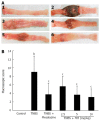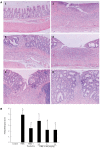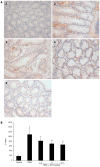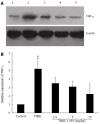Effectiveness of a hydroxynaphthoquinone fraction from Arnebia euchroma in rats with experimental colitis
- PMID: 24409058
- PMCID: PMC3882404
- DOI: 10.3748/wjg.v19.i48.9318
Effectiveness of a hydroxynaphthoquinone fraction from Arnebia euchroma in rats with experimental colitis
Abstract
Aim: To evaluate the potential effectiveness of hydroxynaphthoquinone mixture (HM) in rats with 2,4,6-trinitrobenzene sulfonic acid (TNBS)-induced colitis.
Methods: Colitis was induced by intracolonic administration of TNBS (80 mg/kg, dissolved in 50% ethanol). Rats were treated daily for 7 d with HM (2.5, 5, 10 mg/kg) and mesalazine 100 mg/kg 24 h after TNBS instillation. Disease progression was monitored daily by observation of clinical signs and body weight change. At the end of the experiment, macroscopic and histopathologic lesions of rats were scored, and myeloperoxidase (MPO) activity was determined. We also determined inflammatory cytokine tumor necrosis factor (TNF)-α level by ELISA, Western blotting and immunochemistry to explore the potential mechanisms of HM.
Results: After intracolonic instillation of TNBS, animals developed colitis associated with soft stool, diarrhea and marked colonic destruction. Administration of HM significantly attenuated clinical and histopathologic severity of TNBS-induced colitis in a dose-dependent manner. It abrogated body weight loss, diarrhea and inflammation, decreased macroscopic damage score, and improved histological signs, with a significant reduction of inflammatory infiltration, ulcer size and the severity of goblet cell depletion (all P < 0.05 vs TNBS alone group). HM could reduce MPO activity. In addition, it also decreased serum TNF-α level and down-regulated TNF-α expression in colonic tissue. This reduction was statistically significant when the dose of HM was 10 mg/kg (P < 0.05 vs TNBS alone group), and the effect was comparable to that of mesalazine and showed no apparent adverse effect. The underlying mechanism may be associated with TNF-α inhibition.
Conclusion: These findings suggest that HM possesses favourable therapeutic action in TNBS-induced colitis, which provides direct pharmacological evidence for its clinical application.
Keywords: 2,4,6-trinitrobenzene sulfonic acid-induced colitis; Arnebia euchroma (Royle) Johnst; Hydroxynaphthoquinones; Inflammatory bowel disease; Tumor necrosis factor.
Figures






Similar articles
-
Therapeutic effect of a hydroxynaphthoquinone fraction on dextran sulfate sodium-induced ulcerative colitis.World J Gastroenterol. 2014 Nov 7;20(41):15310-8. doi: 10.3748/wjg.v20.i41.15310. World J Gastroenterol. 2014. PMID: 25386079 Free PMC article.
-
Total glucosides of peony attenuates 2,4,6-trinitrobenzene sulfonic acid/ethanol-induced colitis in rats through adjustment of TH1/TH2 cytokines polarization.Cell Biochem Biophys. 2014 Jan;68(1):83-95. doi: 10.1007/s12013-013-9696-3. Cell Biochem Biophys. 2014. PMID: 23771723
-
Copaifera malmei Harms leaves infusion attenuates TNBS-ulcerative colitis through modulation of cytokines, oxidative stress and mucus in experimental rats.J Ethnopharmacol. 2021 Mar 1;267:113499. doi: 10.1016/j.jep.2020.113499. Epub 2020 Oct 19. J Ethnopharmacol. 2021. PMID: 33091486
-
Dilodendron bipinnatum Radlk. extract alleviates ulcerative colitis induced by TNBS in rats by reducing inflammatory cell infiltration, TNF-α and IL-1β concentrations, IL-17 and COX-2 expressions, supporting mucus production and promotes an antioxidant effect.J Ethnopharmacol. 2021 Apr 6;269:113735. doi: 10.1016/j.jep.2020.113735. Epub 2020 Dec 24. J Ethnopharmacol. 2021. PMID: 33359865
-
Pharmacology, toxicity and pharmacokinetics of acetylshikonin: a review.Pharm Biol. 2020 Dec;58(1):950-958. doi: 10.1080/13880209.2020.1818793. Pharm Biol. 2020. PMID: 32956595 Free PMC article. Review.
Cited by
-
Arnebia euchroma ointment can reduce abdominal fat thickness and abdominal circumference of overweight women: A randomized controlled study.J Res Med Sci. 2016 Aug 1;21:63. doi: 10.4103/1735-1995.187347. eCollection 2016. J Res Med Sci. 2016. PMID: 27904608 Free PMC article.
-
Differential relieving effects of shikonin and its derivatives on inflammation and mucosal barrier damage caused by ulcerative colitis.PeerJ. 2021 Jan 7;9:e10675. doi: 10.7717/peerj.10675. eCollection 2021. PeerJ. 2021. PMID: 33505807 Free PMC article.
-
Short-Chain Naphthoquinone Protects Against Both Acute and Spontaneous Chronic Murine Colitis by Alleviating Inflammatory Responses.Front Pharmacol. 2021 Aug 23;12:709973. doi: 10.3389/fphar.2021.709973. eCollection 2021. Front Pharmacol. 2021. PMID: 34497514 Free PMC article.
-
EFFECTS OF ARNEBIA EUCHROMA EXTRACT ON STREPTOZOTOCIN INDUCED DIABETES IN RATS: A STEREOLOGICAL STUDY.Acta Endocrinol (Buchar). 2017 Jul-Sep;13(3):272-277. doi: 10.4183/aeb.2017.272. Acta Endocrinol (Buchar). 2017. PMID: 31149187 Free PMC article.
-
The Role of Medicinal and Aromatic Plants against Obesity and Arthritis: A Review.Nutrients. 2022 Feb 25;14(5):985. doi: 10.3390/nu14050985. Nutrients. 2022. PMID: 35267958 Free PMC article. Review.
References
-
- Hanauer SB. Inflammatory bowel disease: epidemiology, pathogenesis, and therapeutic opportunities. Inflamm Bowel Dis. 2006;12 Suppl 1:S3–S9. - PubMed
-
- Cosnes J, Gower-Rousseau C, Seksik P, Cortot A. Epidemiology and natural history of inflammatory bowel diseases. Gastroenterology. 2011;140:1785–1794. - PubMed
-
- Huang ZS, Zhang M, Ma L, Gu LQ. A survery of chemical and pharmacologic studies on Zicao. Tianranchanwu Yanjiu Yu Kaifa. 1999;12:73–82.
Publication types
MeSH terms
Substances
LinkOut - more resources
Full Text Sources
Other Literature Sources
Medical
Research Materials
Miscellaneous

